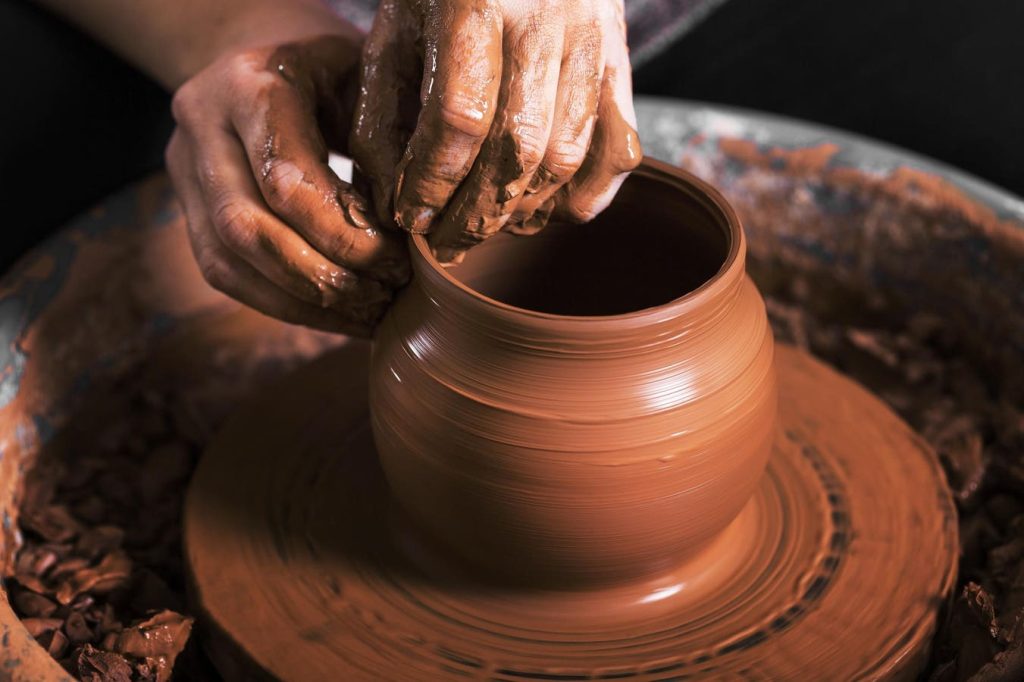“The dignity of clay transcends that of gold and silver.” – Nabahat Lotia
getty
Since she was a child, Nabahat Lotia, a prominent and prolific ceramicist based in Karachi, had a fascination with clay. Often accompanying her father, an agriculturist, to a village known as Prem Nagar (in the province of Punjab), Lotia would watch potters at their wheels in absolute awe.
The smell of the fresh, wet clay as it would spin around the potter’s wheel and the artful ease with which the potter would create a beautiful vessel, captivated Lotia to no end as a child.
It felt like tangible magic manifested from one’s very own hands.
Nabahat Lotia
Kamil Lotia
But it was only many years later, when the artist made a full circle back to her childhood passion for pottery.
While living in Lahore for a few years, Lotia reveals that she set out one day to look for planters to decorate her garden with. What started out as a casual trip, ended with Lotia meeting a master potter – Ustaad Ramzan – who would eventually become her mentor.
A potter stacks pots in a well-shaped kiln in Lahore.
Nabahat Lotia
“I’d sit with him for hours after dropping off my children to school,” she says, adding that Ustaad Ramzan would narrate a number of folk tales while instructing her about a number of clay firing techniques.
“I never thought it would have such an impact on me,” she laughs, while sitting in her childhood friend’s living room in Islamabad, where she was visiting last month.
In the capital for a few weeks, the artist reveals that most of her time was currently focused on designing a breath-taking studio in the mountains for not just potters, but all creatives across Pakistan.
Nabahat sitting in the loading chamber of a kiln in Hyderabad.
Kamil Lotia
The studio, a lifelong dream, is her second big initiative, which she’s incredibly excited about.
However, her first project, Pottery Traditions of Pakistan, a stunning coffee table book, was published last year, after ten long years of research and documentation. Filled with pictures from her travels around the country, the book features a whopping 27 chapters that highlight different traditions of pottery and ceramics across each province – from cities to towns and villages.
“The dignity of clay transcends that of gold and silver,” Lotia writes in her book. “One can truly understand the hard work and endeavour of the craftsmen if one were to witness, from start to finish, the creation of even a small cup.”
The book cover featuring a traditional Pakistani potter throwing a pot on his wheel.
Nabahat Lotia
For Lotia, the comprehensive book – over 300 pages in length – is not just an ode to a diminishing craft, but it also stands as an archive of the country’s culture and heritage, lovingly moulded by the hands of numerous, overlooked potters, just like her mentor, the late Ustaad Ramzan.
During the research, Lotia mentions a small village known as Ghazi Khumar (located in Sindh’s Tharparkar District), which made quite an impact on her.
An artist paints in a technique known as ‘Kashikari’ on a ceramic plate in Multan.
Nabahat Lotia
Named after their great-grandfather, three brothers live with their families in the village, carrying on the traditional pottery work of their forefathers. Completely self-sustained, the brothers, Lotia writes in her book, are not just potters, but make a living as farmers as well. And while the men in the village spearhead the pottery-making, the womenfolk add the decorative finishing touches to each clay piece.
A woman in Thatta, Pakistan, painting freshly-made clay pots.
getty
“There’s so much more that I have to learn,” Lotia states earnestly. “I’m in love with the medium of clay. I enjoy the feel of it, its texture, my connection with it and even the changes clay brings to itself. As a potter, one is always pleasantly surprised by the outcome when one opens the kiln the next morning.”
The city of Hala in Sindh, Pakistan, is famous for its beautiful pottery and tile work.
getty
Having participated in numerous group shows overseas, including residencies in New York, Toronto, Bali, Turkey and Sri Lanka, Lotia has not only taught ceramics and pottery at the college level on home turf, but has also conducted workshops abroad over the years.
Preparing for a show in Istanbul, Turkey.
Nabahat Lotia
“Clay for me is synonymous with life itself,” Lotia says, her eyes lighting up. “The process of pottery-making is precisely like this journey that we’re on. Sometimes you break when you’re put through fire (hardships), and sometimes you come out stronger and far, far more beautiful.”

